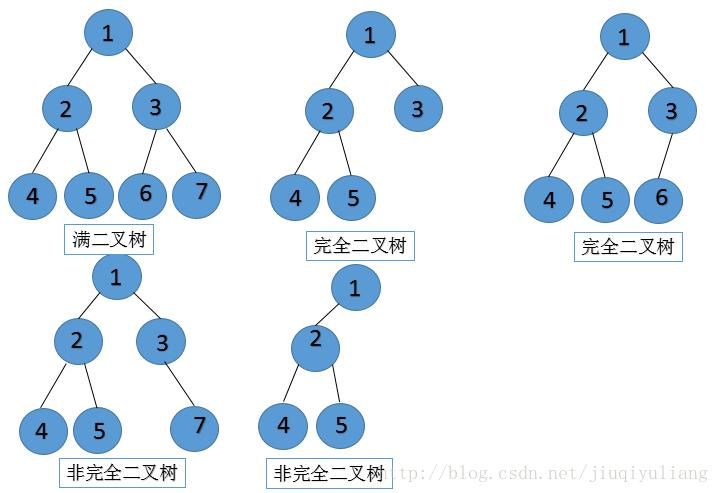1.概念
二叉树:树中每个节点最多只能有两个子节点,这样的树就成为"二叉树"。
完美二叉树(满二叉树):除了最下一层的叶结点外,每层节点都有2个子结点,就构成了满二叉树。
完全二叉树:除二叉树最后一层外,其他各层的节点数都达到最大个数。且最后一层从左向右的叶结点连续存在,只缺右侧若干节点。
如下图所示:

生活中的数结构现象有:族谱,上下级领导等。
二叉树的遍历:先序遍历、中序遍历、后续遍历
(1)先序遍历:访问根结点,先序遍历其左子树,先序遍历其右子树。
(2)中序遍历:中序遍历其左子树,访问根结点,中序遍历其右子树。
(3)后续遍历:后序遍历其左子树,后序遍历其右子树,访问根结点。

2.遍历二叉树
前序遍历
//递归遍历 function preOrder(root) { let res = []; function __preOrder(root) { if (!root) return null; res.push(root.val); __preOrder(root.left); __preOrder(root.right); } __preOrder(root); return res } //非递归遍历 function preOrder(root) { if (!root) return null; let nodes = []; let res = []; nodes.push(root); while(nodes.length) { let node = nodes.pop(); res.push(node.val); node.right && nodes.push(node.right); node.left && nodes.push(node.left); } return res }
中序二叉树
//递归遍历 function midOrder(root) { let res = []; function __midOrder(root) { if (!root) return null; __midOrder(root.left); res.push(root.val); __midOrder(root.right); } __midOrder(root); return res } //非递归遍历 function midOrder(root) { let nodes = []; let res = []; while (root || nodes.length) { if (root) { nodes.push(root); root = root.left; } else { let node = nodes.pop(); res.push(node.val); root = node.right; } } return res }
后序遍历
//递归遍历 function postOrder(root) { let res = []; function __postOrder(root) { if (!root) return null; __postOrder(root.left); __postOrder(root.right); res.push(root.val); } __postOrder(root); return res } //非递归遍历 function postOrder(root) { if (!root) return null; let nodes = []; let res = []; nodes.push(root); while (nodes.length) { let node = nodes.pop(); res.unshift(node.val); node.left && nodes.push(node.left); node.right && nodes.push(node.right); } return res }
层序遍历
//非递归遍历 function levelOrder(root){ // write code here if (!root) return []; let res = []; let nodes = []; nodes.push(root); while(nodes.length) { const len = nodes.length; let tmp = []; for(let i=0; i<len; i++) { let node = nodes.shift(); tmp.push(node.val); node.left && nodes.push(node.left); node.right && nodes.push(node.right); } res.push(tmp); } return res; }
3.封装二叉数
function BinarySerachTree() { // 创建结点构造函数 function Node(key) { this.key = key this.left = null this.right = null } // 保存根的属性 this.root = null BinarySerachTree.prototype.insert = function (key) { var newNode = new Node(key) if (this.root === null) { this.root = newNode } else { this.insertNode(this.root, newNode) } } BinarySerachTree.prototype.insertNode = function (node, newNode) { if (newNode.key < node.key) { if (node.left === null) { node.left = newNode } else { this.insertNode(node.left, newNode) } } else { if (node.right === null) { node.right = newNode } else { this.insertNode(node.right, newNode) } } } //前序遍历 BinarySerachTree.prototype.preOrderTraversal = function (handler) { this.preOrderTranversalNode(this.root, handler) } BinarySerachTree.prototype.preOrderTranversalNode = function (node, handler) { if(node!==null){ handler(node.key) this.preOrderTranversalNode(node.left, handler) this.preOrderTranversalNode(node.right, handler) } } // 中序遍历 BinarySerachTree.prototype.inOrderTraversal = function (handler) { this.inOrderTraversalNode(this.root, handler) } BinarySerachTree.prototype.inOrderTraversalNode = function (node, handler) { if (node !== null) { this.inOrderTraversalNode(node.left, handler) handler(node.key) this.inOrderTraversalNode(node.right, handler) } } // 后续遍历 BinarySerachTree.prototype.postOrderTraversal = function (handler) { this.postOrderTraversalNode(this.root, handler) } BinarySerachTree.prototype.postOrderTraversalNode = function (node, handler) { if (node !== null) { this.postOrderTraversalNode(node.left, handler) this.postOrderTraversalNode(node.right, handler) handler(node.key) } } BinarySerachTree.prototype.min = function () { var node = this.root while (node.left !== null) { node = node.left } return node.key } BinarySerachTree.prototype.max = function () { var node = this.root while (node.right !== null) { node = node.right } return node.key } BinarySerachTree.prototype.search = function (key) { node = this.root while(node!==null){ if(node.key>key){ node = node.left }else if(node.key<key){ node = node.right }else{ return true } } return false } // 删除结点 BinarySerachTree.prototype.remove = function (key) { // 1.定义临时保存的变量 var current = this.root var parent = this.root var isLeftChild = true // 2.开始查找节点 while (current.key !== key) { parent = current if (key < current.key) { isLeftChild = true current = current.left } else { isLeftChild = false current = current.right } // 如果发现current已经指向null, 那么说明没有找到要删除的数据 if (current === null) return false } if (current.left === null && current.right === null) { // 3.删除的结点是叶结点 if (current === this.root) { this.root = null } else if (isLeftChild) { parent.left = null } else { parent.right = null } } else if (current.right === null) { // 4.删除有一个子节点的节点 if (current === this.root) { this.root = current.left } else if (isLeftChild) { parent.left = current.left } else { parent.right = current.left } } else if (current.left === null) { if (current === this.root) { this.root = current.right } else if (isLeftChild) { parent.left = current.right } else { parent.right = current.right } } else { //5.删除有两个节点的节点 // 1.获取后继节点 var successor = this.getSuccessor(current) // 2.判断是否是根节点 if (current === this.root) { this.root = successor } else if (isLeftChild) { parent.left = successor } else { parent.right = successor } // 3.将删除节点的左子树赋值给successor successor.left = current.left } return true } // 找后继(向右找最小的节点)的方法 BinarySerachTree.prototype.getSuccessor = function (delNode) { // 1.使用变量保存临时的节点 var successorParent = delNode var successor = delNode var current = delNode.right // 要从右子树开始找 // 2.寻找节点 while (current != null) { successorParent = successor successor = current current = current.left } if (successor !== delNode.right) { successorParent.left = successor.right successor.right = delNode.right } return successor } }
//测试 var bst = new BinarySerachTree() bst.insert(11) bst.insert(7) bst.insert(15) bst.insert(5) bst.insert(3) bst.insert(9) bst.insert(8) bst.insert(10) bst.insert(13) bst.insert(12) bst.insert(14) bst.insert(20) bst.insert(18) bst.insert(25) bst.insert(6) var resultString = "" bst.preOrderTraversal(function (key) { resultString += key + " " }) console.log(resultString) // 11 7 5 3 6 9 8 10 15 13 12 14 20 18 25 resultString = "" bst.inOrderTraversal(function (key) { resultString += key + " " }) console.log(resultString) // 3 5 6 7 8 9 10 11 12 13 14 15 18 20 25 resultString = "" bst.postOrderTraversal(function (key) { resultString += key + " " }) console.log(resultString) // 3 5 6 7 8 9 10 11 12 13 14 15 18 20 25 console.log(bst.search(10)) // true console.log(bst.search(21)) // false



 浙公网安备 33010602011771号
浙公网安备 33010602011771号